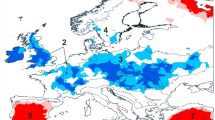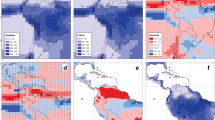Abstract
Human-induced climate change causes significant changes in local climates1,2, which in turn lead to changes in regional climate zones. Large shifts in the world distribution of Köppen–Geiger climate classifications by the end of this century have been projected3. However, only a few studies have analysed the pace of these shifts in climate zones4,5, and none has analysed whether the pace itself changes with increasing global mean temperature. In this study, pace refers to the rate at which climate zones change as a function of amount of global warming. Here we show that present climate projections suggest that the pace of shifting climate zones increases approximately linearly with increasing global temperature. Using the RCP8.5 emissions pathway, the pace nearly doubles by the end of this century and about 20% of all land area undergoes a change in its original climate. This implies that species will have increasingly less time to adapt to Köppen zone changes in the future, which is expected to increase the risk of extinction5.
This is a preview of subscription content, access via your institution
Access options
Subscribe to this journal
Receive 12 print issues and online access
$209.00 per year
only $17.42 per issue
Buy this article
- Purchase on Springer Link
- Instant access to full article PDF
Prices may be subject to local taxes which are calculated during checkout




Similar content being viewed by others
References
Mahlstein, I., Knutti, R., Solomon, S. & Portmann, R. W. Early onset of significant local warming in low latitude countries. Environ. Res. Lett. 6, 034009 (2011).
Mahlstein, I., Portmann, R. W., Daniel, J. S., Solomon, S. & Knutti, R. Perceptible changes in regional precipitation in a future climate. Geophys. Res. Lett. 39, L05701 (2012).
Rubel, F. & Kottek, M. Observed and projected climate shifts 1901–2100 depicted by world maps of the Köppen–Geiger climate classification. Meteorol. Z. 19, 135–141 (2010).
Burrows, M. T. et al. The pace of shifting climate in marine and terrestrial ecosystems. Science 334, 652–655 (2011).
Sandel, B. et al. The influence of late quaternary climate-change velocity on species endemism. Science 334, 660–664 (2011).
Williams, J. W., Jackson, S. T. & Kutzbacht, J. E. Projected distributions of novel and disappearing climates by 2100 AD. Proc. Natl Acad. Sci. USA 104, 5738–5742 (2007).
Gnanadesikan, A. & Stouffer, R. J. Diagnosing atmosphere-ocean general circulation model errors relevant to the terrestrial biosphere using the Köppen climate classification. Geophys. Res. Lett. 33, L22701 (2006).
Köppen, W. The thermal zones of the Earth according to the duration of hot, moderate and cold periods and to the impact of heat on the organic world. Meteorol. Z. 20, 351–360 (2011).
Taylor, K. E., Stouffer, R. J. & Meehl, G. A. An overview of CMIP5 and the experiment design. Bull. Am. Meteorol. Soc. 93, 485–498 (2011).
Van Vuuren, D. P. et al. The representative concentration pathways: An overview. Climatic Change 109, 5–31 (2011).
Rogelj, J., Meinshausen, M. & Knutti, R. Global warming under old and new scenarios using IPCC climate sensitivity range estimates. Nature Clim. Change 2, 248–253 (2012).
Hansen, J. E. A slippery slope: How much global warming constitutes ‘dangerous anthropogenic interference’? Climatic Change 68, 269–279 (2005).
Randalls, S. History of the 2 °C climate target. WIRes Climatic Change 1, 598–605 (2010).
Richard, S. J. T. Europe’s long term climate target: A critical evaluation. Energy Policy 35, 424–434 (2005).
Noake, K., Polson, D., Hegerl, G. & Zhang, X. Changes in seasonal land precipitation during the latter twentieth-century. Geophys. Res. Lett. 39, L03706 (2012).
Zhang, X. B. et al. Detection of human influence on twentieth-century precipitation trends. Nature 448, 461–464 (2007).
Liu, C., Allan, R. P. & Huffman, G. J. Co-variation of temperature and precipitation in CMIP5 models and satellite observations. Geophys. Res. Lett. 39, L13803 (2012).
Sherwood, S. C. & Huber, M. An adaptability limit to climate change due to heat stress. Proc. Natl Acad. Sci. USA 107, 9552–9555 (2010).
Meinshausen, M. et al. The RCP greenhouse gas concentrations and their extensions from 1765 to 2300. Climatic Change 109, 213–241 (2011).
Kottek, M., Grieser, J., Beck, C., Rudolf, B. & Rubel, F. World map of the Köppen–Geiger climate classification updated. Meteorol. Z. 15, 259–263 (2006).
Rienecker, M. M. et al. MERRA: NASA’s modern-era retrospective analysis for research and applications. J. Clim. 24, 3624–3648 (2011).
Xie, P. P. & Arkin, P. A. Global precipitation: A 17-year monthly analysis based on gauge observations, satellite estimates, and numerical model outputs. Bull. Am. Meteorol. Soc. 78, 2539–2558 (1997).
IPCC Climate Change 2007: The Physical Science Basis (eds Solomon, S. et al.) (Cambridge Univ. Press, 2007).
Acknowledgements
We acknowledge the World Climate Research Programme’s Working Group on Coupled Modelling, which is responsible for CMIP, and we thank the climate modelling groups for producing and making available their model output. For CMIP the US Department of Energy’s Program for Climate Model Diagnosis and Intercomparison provides coordinating support and led development of software infrastructure in partnership with the Global Organization for Earth System Science Portals. We also thank U. Beyerle, J. Sedlacek and T. Corti for downloading and regridding the model data.
Author information
Authors and Affiliations
Contributions
I.M., J.S.D. and S.S. designed the study; I.M. did all the analysis shown in the study; I.M., J.S.D. and S.S. wrote the paper.
Corresponding author
Ethics declarations
Competing interests
The authors declare no competing financial interests.
Supplementary information
Rights and permissions
About this article
Cite this article
Mahlstein, I., Daniel, J. & Solomon, S. Pace of shifts in climate regions increases with global temperature. Nature Clim Change 3, 739–743 (2013). https://doi.org/10.1038/nclimate1876
Received:
Accepted:
Published:
Issue Date:
DOI: https://doi.org/10.1038/nclimate1876
This article is cited by
-
Carbon sink and source function of Eastern Himalayan forests: implications of change in climate and biotic variables
Environmental Monitoring and Assessment (2023)
-
Shifting climate zones and expanding tropical and arid climate regions across Kenya (1980–2020)
Regional Environmental Change (2023)
-
The impacts of global warming on arid climate and drought features
Theoretical and Applied Climatology (2023)
-
Drought disaster monitoring and land use dynamics: identification of drought drivers using regression-based algorithms
Natural Hazards (2022)
-
Eco-geographical Regionalization of China: An Approach Using the Rough Set Method
Chinese Geographical Science (2022)



